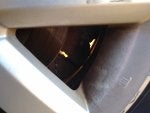After 15 years the rear brake back plates on my 07 are rusting. (aka: backing plate, dust cover, dust shield, brake splash guard )
The plate appears to be made up of two parts, a center part, which is clamped between the rear (trailing) arm and the bearing hub, and an outer section that is spot welded to the center and sort of wraps around the brake rotor. In the image below, we can see the spot welds. The rust follows around the center part along the red line but in a wider band that reaches about 1/2-way out to the circumference. (The fact that it's two separate pieces, probably with some gaps, likely provides a space for rust to being and spread out in the thinner outer material.)
![Image]()
From what I've seen in older Subarus, eventually that outer part breaks away in the shape of a large "C". There's a few posts here about it, in some cases it was being replaced, in others there were suggestions to just leave it off.
Obviously, the center part of the assembly is important, as it forms the interface between the rear (trailing) arm and the wheel bearing hub. But what about the outer section? Exactly what is it's purpose and how does it achieve that, given it's not really sealing anything. (I would imagine there is a purpose/need, otherwise it wouldn't be there.) If it is off, the inboard side of the rotor is exposed, but then the outboard side is exposed all the time. Could it be meant to prevent dust from getting inside the parking brake assembly, or even the hub? Any long term negative effects? Is it safety-related in some way?
I guess my questions are leading to: If it were to come off, should it be replaced? I'm not averse to that if it's reasonably necessary. But I can see it being a challenging job as it requires removing the wheel hub in addition to the brake assemblies (disk and parking). The hub is probably rusted in as well, which could lead to it being damaged on removal and having to be replaced. It won't be inexpensive, and I'll probably have to do both sides.
Your views?
Part details:
![Image]()
The plate appears to be made up of two parts, a center part, which is clamped between the rear (trailing) arm and the bearing hub, and an outer section that is spot welded to the center and sort of wraps around the brake rotor. In the image below, we can see the spot welds. The rust follows around the center part along the red line but in a wider band that reaches about 1/2-way out to the circumference. (The fact that it's two separate pieces, probably with some gaps, likely provides a space for rust to being and spread out in the thinner outer material.)
From what I've seen in older Subarus, eventually that outer part breaks away in the shape of a large "C". There's a few posts here about it, in some cases it was being replaced, in others there were suggestions to just leave it off.
Obviously, the center part of the assembly is important, as it forms the interface between the rear (trailing) arm and the wheel bearing hub. But what about the outer section? Exactly what is it's purpose and how does it achieve that, given it's not really sealing anything. (I would imagine there is a purpose/need, otherwise it wouldn't be there.) If it is off, the inboard side of the rotor is exposed, but then the outboard side is exposed all the time. Could it be meant to prevent dust from getting inside the parking brake assembly, or even the hub? Any long term negative effects? Is it safety-related in some way?
I guess my questions are leading to: If it were to come off, should it be replaced? I'm not averse to that if it's reasonably necessary. But I can see it being a challenging job as it requires removing the wheel hub in addition to the brake assemblies (disk and parking). The hub is probably rusted in as well, which could lead to it being damaged on removal and having to be replaced. It won't be inexpensive, and I'll probably have to do both sides.
Your views?
Part details:
2007 Subaru Outback 2.5L 4AT Base Brake Dust Shield. Brake Splash Guard. Plate Brake (Right, Rear, Back) - 26704AE040 - Genuine Subaru Part
Brake Dust Shield. Brake Splash Guard. Plate Brake (Right, Rear, Back). 2007 Subaru Outback 2.5L 4AT Base. Genuine Subaru Part - 26704AE040
parts.subaru.com





